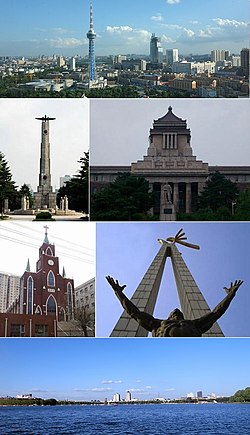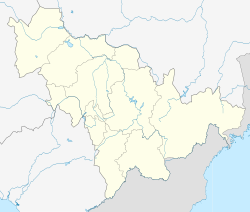Hsinking
|
Changchun 长春市 |
|
|---|---|
| Sub-provincial city | |

Clockwise from top: panoramic view from Ji Tower, Former Manchukuo State Department, Statue on cultural square, Changchun Christian Church, Soviet martyr monument.
|
|
| Nickname(s): 北国春城 (Spring City of the Northern Country) | |
 Changchun (red) in Jilin (orange) |
|
| Location of the city centre in Jilin | |
| Coordinates: 43°54′N 125°12′E / 43.900°N 125.200°ECoordinates: 43°54′N 125°12′E / 43.900°N 125.200°E | |
| Country | China |
| Province | Jilin |
| County-level divisions | 7 districts 2 county-level divisions 1 county |
| Incorporated (town) | 1889 |
| Incorporated (city) | 1932 |
| Government | |
| • Party Secretary | Wang Junzheng |
| • Mayor | Liu Changlong |
| Area | |
| • Sub-provincial city | 20,604 km2 (7,955 sq mi) |
| • Urban | 4,738 km2 (1,829 sq mi) |
| • Metro | 3,061 km2 (1,182 sq mi) |
| Elevation | 222 m (730 ft) |
| Population (2010 census) | |
| • Sub-provincial city | 7,674,439 |
| • Density | 370/km2 (960/sq mi) |
| • Urban | 4,193,073 |
| • Urban density | 880/km2 (2,300/sq mi) |
| • Metro | 3,815,270 |
| • Metro density | 1,200/km2 (3,200/sq mi) |
| Time zone | China Standard (UTC+8) |
| Postal code | 130000 |
| Area code(s) | 0431 |
| License plate prefixes | 吉A |
| GDP (2010) | CNY 332.9 billion |
| - per capita | CNY 43,378 |
| ISO 3166-2 | cn-22-01 |
| Website | www.changchun.gov.cn |
| Changchun | |||||||||||||||||||||||||

"Chángchūn", as written in Simplified Chinese
|
|||||||||||||||||||||||||
| Chinese name | |||||||||||||||||||||||||
|---|---|---|---|---|---|---|---|---|---|---|---|---|---|---|---|---|---|---|---|---|---|---|---|---|---|
| Simplified Chinese | |||||||||||||||||||||||||
| Traditional Chinese | |||||||||||||||||||||||||
| Hanyu Pinyin | Chángchūn | ||||||||||||||||||||||||
| Literal meaning | Long Spring | ||||||||||||||||||||||||
|
|||||||||||||||||||||||||
| Hsinking | |||||||||||||||||||||||||
| Chinese | |||||||||||||||||||||||||
| Hanyu Pinyin | Xīnjīng | ||||||||||||||||||||||||
| Literal meaning | New Capital | ||||||||||||||||||||||||
|
|||||||||||||||||||||||||
| Manchu name | |||||||||||||||||||||||||
| Manchu script | ᠴᠠᠨᡤᠴᠣᠨ | ||||||||||||||||||||||||
| Romanization | Cangcon | ||||||||||||||||||||||||
| Transcriptions | |
|---|---|
| Standard Mandarin | |
| Hanyu Pinyin | Chángchūn |
| Bopomofo | ㄔㄤˊ ㄔㄨㄣ |
| Gwoyeu Romatzyh | Charngchuen |
| Wade–Giles | Chʻang2-chʻun1 |
| Wu | |
| Romanization | zan平tshen平 |
| Yue: Cantonese | |
| Jyutping | coeng4ceon1 |
| Southern Min | |
| Hokkien POJ | Tiông-chhun |
| Transcriptions | |
|---|---|
| Standard Mandarin | |
| Hanyu Pinyin | Xīnjīng |
| Bopomofo | ㄒㄧㄣ ㄐㄧㄥ |
| Gwoyeu Romatzyh | Shinjing |
| Wade–Giles | Hsin1-ching1 |
| Yale Romanization | Syīnjīng |
Changchun (Chinese: 长春; pinyin: Chángchūn) is the capital and largest city of Jilin Province, and is located in the northeast of China. Lying in the center of the Songliao Plain, Changchun is administered as a sub-provincial city, comprising 7 districts, 1 county and 2 county-level cities. According to the 2010 census of China, Changchun had a total population of 7,674,439 under its jurisdiction. The city's urbanized (or metro) area, comprising 5 districts and 4 development areas, had a population of 3,815,270 in 2010 as the Shuangyang and Jiutai districts are not urbanized yet.
The name of the city means "long spring" in Chinese. Between 1932 and 1945, Changchun was renamed Hsinking (Chinese: 新京; pinyin: Xīnjīng; literally: "new capital") by the Japanese as it became the capital of the Japanese puppet state Manchukuo, occupying modern Northeast China. After the foundation of the People's Republic of China in 1949, Changchun was established as the provincial capital of Jilin in 1954.
Known locally as China's "City of Automobiles", Changchun is an important industrial base with a particular focus on the automotive sector. Because of its key role in the domestic automobile industry, Changchun was sometimes referred to as the "Detroit of China." Apart from this industrial aspect, Changchun is also one of four "National Garden Cities" awarded by the Ministry of Construction of P.R. China in 2001 due to its high urban greening rate.
Changchun was initially established on imperial decree as a small trading post and frontier village during the reign of the Jiaqing Emperor in the Qing dynasty. Trading activities mainly involved furs and other natural products during this period. In 1800, the Jiaqing Emperor selected a small village on the east bank of the Yitong River and named it "Changchun Ting".
...
Wikipedia

